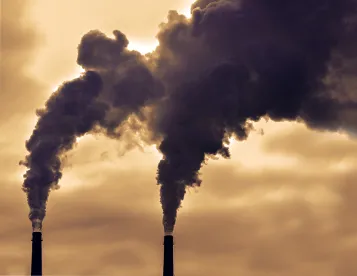On January 13, 2021, the state of New York, through the New York State Department of Environmental Conservation (NYSDEC), became only the second state in the United States to regulate PFAS in air emissions. New York proposed a regulation on air emissions for perfluorooctanoic acid (PFOA) – one type of PFAS – that would set an allowable concentration limit for PFOA that will have significant impact on industrial compliance practices. Failure to comply with the proposed regulations would expose companies to costly fines and penalties; however, pre-emptive action now to ensure full compliance will yield long-term cost savings.
What Are PFAS and Why Are They a Concern?
Per- and poly-fluoroalkyl substances (“PFAS”) are a class of over 7,000 manmade compounds. Chemists at 3M and Dupont developed the initial PFAS chemicals by accident in the 1930s when researching carbon-based chemical reactions. During one such experiment, an unusual coating remained in the testing chamber, which upon further testing was completely resistant to any methods designed to break apart the atoms within the chemical. The material also had the incredible ability to repel oil and water. Dupont later called this substance PFOA (perfluorooctanoic acid), the first PFAS ever invented. After World War II, Dupont commercialized PFOA into the revolutionary product that the company branded “Teflon.”
Only a short while later, 3M invented its own PFAS chemical – perfluorooctane sulfonate (PFOS), which they also commercialized and branded “Scotchgard.” Within a short period of time, various PFAS chemicals were used in hundreds of products – today, it numbers in the thousands.
The same physical characteristics that make PFAS useful in a plethora of commercial applications, though, also make them highly persistent and mobile in the environment and the human body – hence the nickname, “forever chemicals.” While the science is still developing regarding the extent of possible effects on human health, initial research has shown that PFOA and PFOS are capable of causing certain types of cancer, liver and kidney issues, immunological problems, and reproductive and developmental harm.
New York’s PFAS Air Emissions Standard
The NYSDEC published its Environmental Notice Bulletin that that proposes an allowable concentration in ambient air for PFOA of 0.0053 µg/m3. The concentration level – called an annual guideline concentration (AGC) – only pertains to PFOA, which has led some critics to claim that the proposed regulation does not go far enough, since PFOA have largely been phased out from use in the United States. Instead, critics argue, the regulation should have encompassed more of the over 7,000 PFAS compounds to account for the vast number of recently created PFAS that are more widely used today in industrial settings. However, the counter argument to this position points out that virtually nothing is known about any of the PFAS compounds aside from PFOA and PFOS, so a more broad-sweeping regulation by New York would be unnecessary, unsupported by scientific evidence, and incredibly burdensome on industry given what would be an ensuing push to find substitutes for compounds that may not need stringent regulations.
What is notable about the proposed AGC for PFOA in New York is that the 0.0053 µg/m3 level is well below AGCs for other air pollutants that are far more prevalent in industrial settings, such as benzene, lead, and formaldehyde. In addition, the New York AGC is only the second regulation of any type of PFAS through air emissions by any state in the United States. The only other state to enact a PFAS regulation for air emissions is Michigan. In Michigan, the state regulated air emissions for both PFOA and PFOS, with an allowable concentration level of 0.07 µg/m³ or less, with a 24-hour averaging time. The 0.07 µg/m³ limit applies to PFOA and PFOS individually if only one is present in the air, or a combined limit value if both compounds are present in the air concurrently.
Impacts On Business From PFAS Air Emissions Standards
To date, virtually all of the regulatory attention to PFAS has been through drinking water concerns and regulations. Some states have also regulated firefighting foam and food packaging over PFAS concerns, but regulations of air emissions have a much more direct – and potentially costly – impact on businesses. If the New York regulation is enacted (the comment period ends on February 12, 2021), companies will be faced with significant compliance assessment needs both up front (i.e. – a full supply chain audit for potential PFOA composition of any materials or products purchased) and at the end of the industrial life cycle process (i.e. – smokestack emissions). These actions by themselves will add potentially unplanned costs for businesses; however, they are well worth the short term unplanned expenditure in order to avoid potentially costly long term fines or penalties that stem from non-compliance.
Further, if PFOA emissions are a concern for a company and it is looking to determine how to ensure compliance, costs will need to be planned for in order to purchase and install the appropriate technology capable of eliminating PFAS to a degree such that the AGC can be met. Locating this technology at the best competitive price point will take time, so early planning is advisable.
Finally, businesses with presence in New York and additional states should consider the potential costs and benefits to implementing a full corporate compliance change to mirror steps that might be needed to comply with the New York air emissions regulations. While only two states to date regulate PFAS in air emissions, other states with more progressive action already taken with respect to PFAS (for example, California, New Jersey, Massachusetts) may follow suit more quickly than companies anticipate. Speaking to professionals with expertise in legislative tracking is key to determining whether similar regulations for PFAS in air emissions may be on the horizon in other states.




 />i
/>i

